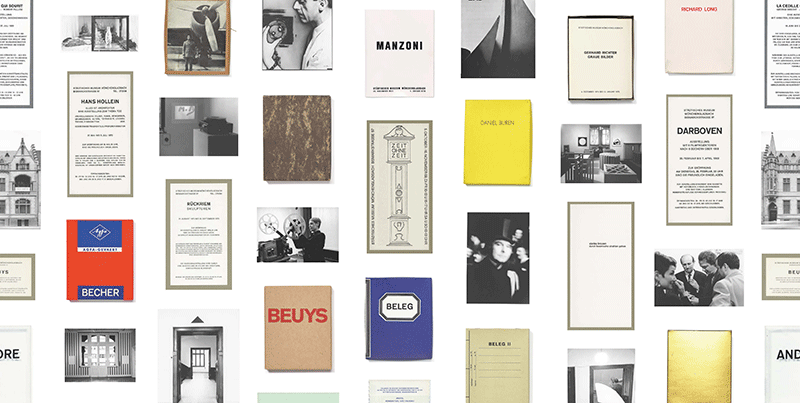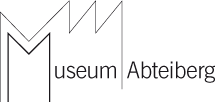
www.museum-moenchengladbach-1967-1978.de
The Exhibitions and Box Catalogues of the Städtisches Museum Mönchengladbach 1967–1978
digital archive project
initiated by Susanne Rennert & Susanne Titz
Digital archive project launch
starting now
test run online with the first 32 chapters
public presentation of the new website and open discussion with
members of the production team
Sunday, January 29, 2023, 3 pm
Museum Abteiberg presents a new website: The Exhibitions and Box Catalogues of the Städtisches Museum Mönchengladbach 1967–1978, www.museum-moenchengladbach-1967-1978.de. The digital archive project documents and visualizes Museum Abteiberg’s prehistory along with the renowned exhibition and education- and mediation program that former director Johannes Cladders (1924–2009) developed for the old Städtisches Museum on Bismarckstraße. Museum Abteiberg marks the launch of this fundamental historical resource with a January 29, 2023 event and presentation featuring contributors and invited guests.
The archive encompasses findings from comprehensive research that Düsseldorf-based art historian Susanne Rennert has been conducting for Museum Abteiberg since 2016. Following on from the 2020 print publication The Box Catalogues of the Städtisches Museum Mönchengladbach 1967–1978, the digital publication offers even more insight into the Mönchengladbach museum’s program between 1967 and 1978 — including many previously unknown documents and meticulously researched discoveries.
*Due to the large volume of text and material, the website will initially appear in German only. We are, however, aware of the considerable interest in the history of the Cladders era in Mönchengladbach, which is why we wanted to provide information about it now. Our goal is to make this long-awaited resource accessible to the international research community as quickly as possible. We hope to offer an English-language version of it at a later date.
This digital archive is a pilot concept; it was designed and realized with support from Museum Digital, a funding program of the Federal State of North Rhine-Westphalia. It is preceded by “VON DA AN (FROM THEN ON): Spaces, Works, Visualizations from the Anti-Museum 1967–1978,” a 2017/18 exhibition and event project curated by Susanne Titz, Susanne Rennert, and Olivier Foulon with funding from the Rhineland Regional Association (LVR), the State of North Rhine-Westphalia, Kunststiftung NRW, and the German Federal Cultural Foundation (Kulturstiftung des Bundes).
Author: Susanne Rennert
Concept: Susanne Rennert, Susanne Titz, Petra Hollenbach
Editing & Production Team: Susanne Rennert, Susanne Titz, Stephanie Passul, Henrike Robert, Jonas Keck, Gian Marco Hölk
Data Manager: Jonas Keck
Creative Direction: Studio von Monkiewitsch, Cologne
Production: Tobias Sawitzki for Studio von Monkiewitsch
PROJECT BACKGROUND AND CONCEPT
The digital archive manifests what was originally planned as a print-only publication of the historical research project Johannes Cladders, The Exhibitions and Box Catalogues of the Städtisches Museum Mönchengladbach, 1967 to 1978. This concludes a process that was initiated in 2016, when Museum Abteiberg commissioned art historian Susanne Rennert to reappraise and reconstruct the now-famous exhibition and publication history of the old
Städtisches Museum on Bismarckstraße. Taking the archival holdings of Museum Abteiberg as her starting point, Rennert sifted through, organized, described, and contextualized the extensive materials, supplemented sources with research in other archives, and conducted interviews with numerous contemporary witnesses. The result is the first detailed insight into the complex production processes surrounding the 86 exhibitions and events that progressive museum director Johannes Cladders (1924–2009) realized here from 1967 to 1978, all in close cooperation with mostly young artists and within highly efficient international networks. This is also the first publication to address the lesser-known exhibitions that Cladders realized with local and regional artist groups over those years, as well as his curatorial concepts for presentations of works in the museum’s collection and its historical holdings (these included, among other things, Coptic textiles, ceramics, and metalware).
It also takes another detailed look at the 35 box catalogues of the Cladders era: publications that radically redefined the traditional “exhibition catalogue” as an object and complementary medium. Together with the exhibitions, they established the Mönchengladbach museum’s extraordinary reputation as a leading contemporary art institution. Working amid the socio-political issues of the day — democratization, de-hierarchization, expansion of consciousness — the museum in Mönchengladbach sought to test a new approach to museum work, as well as new display and education/mediation formats for conceptual, process-based, inter-media and ephemeral articulations of contemporary art.
The Exhibitions and Box Catalogues of the Städtisches Museum Mönchengladbach 1967—1978 digital archive incorporates heterogeneous material: current and historical texts, photographs, archival material, press clippings, audio and video documents, etc. Its realization demanded a structure that is at once fixed and variable, an inspiring combination of the reporting format and the classic archive. Drawing on ideas previously articulated by Susanne Rennert, Susanne Titz, and Petra Hollenbach, the Cologne-based Studio von Monkiewitsch conceived a completely new concept for archive’s display.
The choice to release a digital version of the museum archive stems from a desire to reach a larger, more diverse readership than a traditional book format might. Moreover, the digital adaptation ties into notions of implementing a pilot project on the topic of the archive and its complex networked structures, one that would prove future-proof and could be adapted to other digital formats. Moreover, it offers an opportunity to realize Cladders’ 1968 vision of the museum as a living, active, creative, democratic “anti-museum in perpetuity.”
THANKS AND OUTLOOK
Museum Abteiberg and the author would like to take this opportunity to thank the artists as well as their families, rights holders, and all other participating protagonists and contemporaries who made this project possible. Special thanks to the Johannes Cladders Estate in particular.
The project team is grateful for any further information and documents that might expand the archive project’s knowledge base.
CONTACT FOR FURTHER INFORMATION / TO SCHEDULE INTERVIEWS WITH THE PROJECT TEAM
Henrike Robert
Presse- und Öffentlichkeitsarbeit
robert@museum-abteiberg.de
+49 2161 252636


